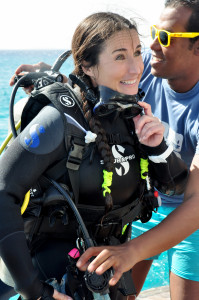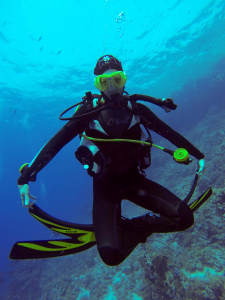 Alexandra Dimitriou-Engeler is a PADI Dive Center owner in Agia Napa, Cyprus. She became a diver in 1992 and received her bachelor’s degree in Oceanography at Plymouth University in 2003. Her love of the ocean has always been her driving force, and this has led to the natural progression of becoming a diving instructor in 2005. She is currently a PADI staff instructor and owner of Scuba Monkey Ltd and is writing a series of guest blogs for PADI Europe, Middle East and Africa. Her next article shares advice on teaching the tricky skill of hovering to new students…
Alexandra Dimitriou-Engeler is a PADI Dive Center owner in Agia Napa, Cyprus. She became a diver in 1992 and received her bachelor’s degree in Oceanography at Plymouth University in 2003. Her love of the ocean has always been her driving force, and this has led to the natural progression of becoming a diving instructor in 2005. She is currently a PADI staff instructor and owner of Scuba Monkey Ltd and is writing a series of guest blogs for PADI Europe, Middle East and Africa. Her next article shares advice on teaching the tricky skill of hovering to new students…
Good buoyancy control is one of the most important skills that a diver must master for two reasons: It keeps the diver in control throughout their dive and protects the marine environment at the same time.
Many students find hovering a tough skill to master. I know I did when I was an open water student, and that was over 20 years ago. I can still remember the frustration of not getting it right the first time. I can also remember the calm reassuring voice of my instructor.
So let’s see why students struggle sometimes.
Being overweighted: Take a lot of time with your guests when you first enter the water on day one. If a diver is overweighted, hovering is a nightmare. Take the extra time at the beginning and you will save time later.
Not thinking about how they are breathing: Try to emphasize that buoyancy should become a habit, and they should not just treat it as an isolated skill. Get them thinking about their breathing. Nothing more than that. Just make them aware from day one.
Getting Frustrated: Emphasize that hovering will take a little time, and because it is a skill that is controlled largely by the lungs, any changes to their rhythm of breathing will affect their success. If they get frustrated, their breathing will change, which will make it harder to control their buoyancy…. then they will get even more frustrated and the issue compounds itself.

So, what techniques can help you help your student?
#1 – Briefing
I like to tell my students the steps that I will go through before going into a hover. I ask them to kneel, stand or lie on the bottom, but I also emphasize the notion that, soon, contact with the floor will be eliminated altogether. I ask them to visualize their lungs once they get into the position that they would like to stay in for 30 seconds.
“Hovering requires control and it requires calmness” – This is my opening line when I start briefing them about this skill.
I keep this briefing for hovering only. I reassure them that they will be able to do it because they have already done multiple fin pivots and that hovering is almost the same – except this time ALL of their body will be off the bottom. I warn them that this is tricky because it is mostly about feeling the differences in their buoyancy as they inhale and exhale.
“As soon as you feel your body start to rise…. Exhale.
“As soon as you feel your body start to get deeper then inhale”
I repeat this several times. I show them how to signal this thought process underwater.
I find that keeping my voice to an almost yoga whisper keeps their nerves at bay. I keep repeating that they should stay calm, to have fun with this lesson and within a very short while they will never touch the bottom again if they don’t want to. I tell them that this is where the magic happens.
#2 Underwater
I find that this briefing is the key to success underwater. Students are prepared for the possibility that hovering will take time and therefore they give themselves the mental space to get their head around the physics of it.

I demonstrate the exaggerated breathing hand gestures that we instructors have used since our IDC. I get my legs into position and inflate my BC in tiny bursts to get to that bouncy feeling, signifying that I am neutrally buoyant. I show them that I am inhaling, that I start to rise because of it and that I exhale just as I get to the mid-water position. I show them the signal for thinking. Thinking about how full my lungs are as I control my position in the water.
In my experience students get to the mid-water point quite easily, but they cannot help but try to balance themselves with their hands and fins. Let them do it for a few seconds before gently silencing the movement. You are looking for a calm face. Let them feel the movement of a slightly-too-deep inhalation – how they ascend a little too far as a result. Let them feel it – don’t correct them too early but also be ready to stop them if they go up too fast. It’s a fine line between trial and error. Keep them safe above all but give them some learning room.
It won’t be long before they’re hovering like a pro – and they will remember your methods long after they have completed their first logbook entry all the way to the day when they might be teaching their very own students to hover!
Don’t forget, once your students have completed their PADI Open Water Diver course, they can sign up to complete a PADI Peak Performance Buoyancy specialty course to further improve their diving skills. For more information on becoming a PADI Peak Performance Specialty Instructor, click here or contact the PADI Training department.


